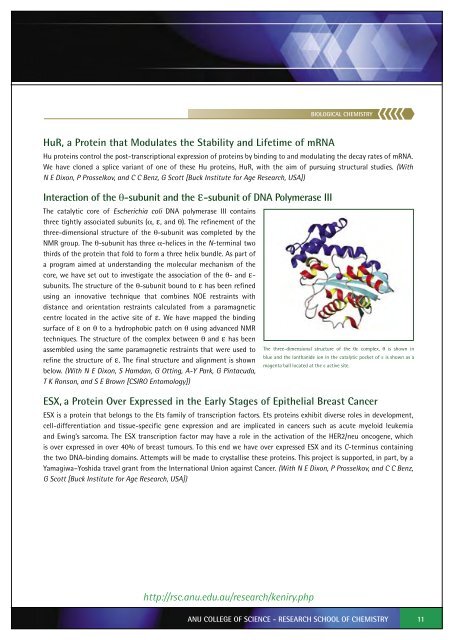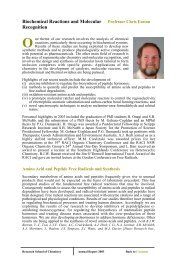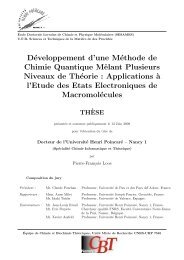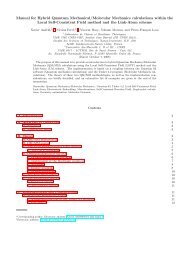View 2005 Report - RSC - Australian National University
View 2005 Report - RSC - Australian National University
View 2005 Report - RSC - Australian National University
You also want an ePaper? Increase the reach of your titles
YUMPU automatically turns print PDFs into web optimized ePapers that Google loves.
BIOLOGICAL CHEMISTRY<br />
HuR, a Protein that Modulates the Stability and Lifetime of mRNA<br />
Hu proteins control the post-transcriptional expression of proteins by binding to and modulating the decay rates of mRNA.<br />
We have cloned a splice variant of one of these Hu proteins, HuR, with the aim of pursuing structural studies. (With<br />
N E Dixon, P Prosselkov, and C C Benz, G Scott [Buck Institute for Age Research, USA])<br />
Interaction of the θ-subunit and the ε-subunit of DNA Polymerase III<br />
The catalytic core of Escherichia coli DNA polymerase III contains<br />
three tightly associated subunits (α, ε, and θ). The refinement of the<br />
three-dimensional structure of the θ-subunit was completed by the<br />
NMR group. The θ-subunit has three α-helices in the N-terminal two<br />
thirds of the protein that fold to form a three helix bundle. As part of<br />
a program aimed at understanding the molecular mechanism of the<br />
core, we have set out to investigate the association of the θ- and ε-<br />
subunits. The structure of the θ-subunit bound to ε has been refined<br />
using an innovative technique that combines NOE restraints with<br />
distance and orientation restraints calculated from a paramagnetic<br />
centre located in the active site of ε. We have mapped the binding<br />
surface of ε on θ to a hydrophobic patch on θ using advanced NMR<br />
techniques. The structure of the complex between θ and ε has been<br />
assembled using the same paramagnetic restraints that were used to<br />
refine the structure of ε. The final structure and alignment is shown<br />
below. (With N E Dixon, S Hamdan, G Otting, A-Y Park, G Pintacuda,<br />
T K Ronson, and S E Brown [CSIRO Entomology])<br />
The three-dimensional structure of the θε complex. θ is shown in<br />
blue and the lanthanide ion in the catalytic pocket of ε is shown as a<br />
magenta ball located at the ε active site.<br />
ESX, a Protein Over Expressed in the Early Stages of Epithelial Breast Cancer<br />
ESX is a protein that belongs to the Ets family of transcription factors. Ets proteins exhibit diverse roles in development,<br />
cell-differentiation and tissue-specific gene expression and are implicated in cancers such as acute myeloid leukemia<br />
and Ewing’s sarcoma. The ESX transcription factor may have a role in the activation of the HER2/neu oncogene, which<br />
is over expressed in over 40% of breast tumours. To this end we have over expressed ESX and its C-terminus containing<br />
the two DNA-binding domains. Attempts will be made to crystallise these proteins. This project is supported, in part, by a<br />
Yamagiwa–Yoshida travel grant from the International Union against Cancer. (With N E Dixon, P Prosselkov, and C C Benz,<br />
G Scott [Buck Institute for Age Research, USA])<br />
http://rsc.anu.edu.au/research/keniry.php<br />
ANU COLLEGE OF SCIENCE - RESEARCH SCHOOL OF CHEMISTRY<br />
11






